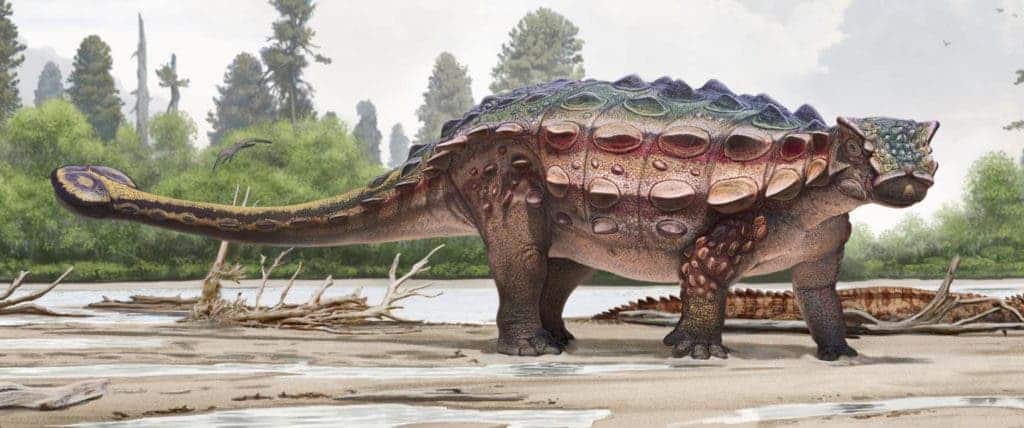A new species of dinosaur has been discovered in Utah — and it seems to be more closely related to species in Asia than those in North America.

Image credits Andrey Atuchin // The Denver Museum of Nature & Science.
The fossil of a new genus and species of ankylosaur has been unearthed in the Kaiparowits Formation of Grand Staircase-Escalante National Monument (GSENM), in Kane County, southern Utah. Dubbed Akainacephalus johnsoni, the dino is helping reveal the complicated evolutionary history of the club-tailed, bone-plated reptiles.
The fossil represents the most complete skeleton of an ankylosaurid dinosaur ever discovered in the southwestern US, its discoverers report. It includes a complete skull, much of the vertebral column, a complete tail club, fore and hind limbs elements, and bony body armor that includes two neck rings and spiked armor plates.
Made in China-ish
After analyzing the remains, the team found that it is distinct enough from anything else in the fossil record to warrant its own species and genus. The name Akainacephalus johnsoni is derived from the Greek words ‘akaina’ (meaning ‘thorn’ or ‘spike’) and cephalus (‘head’). The ‘johnsoni’ honors Randy Johnson, a volunteer at the museum who helped prepare the specimen — the whole painstaking process took almost four years to complete.
“I’m a retired chemist, but I’ve always been interested in most of the science disciplines. I never thought that I would have the opportunity to actually work on fossils that could be important for paleontologists,” Johnson says.
“Now that I’m a museum volunteer, I’m getting the opportunity to work on a large variety of fossils and consult with top paleontologists – it’s like a dream second career. I couldn’t believe it when they told me they are naming the ankylosaur after me, a once in a lifetime honor.”
But exactly what sets this dinosaur apart from its peers surprised even the team. Instead of following the same trend laid out by North American ankylosaurids during its time (the Late Cretaceous), such as smooth armor plates on its skull, A. johnsoni is more similar to Asian ankylosaurids — who sport pronounced spikes on their skull plates.
The arrangement of the dinosaur’s bony armor — which features small cones and pyramids — was the key giveaway that it is more closely related to Asian species (such as Saichania and Tarchia) than to other North American species of its time (including Ankylosaurus and Euoplocephalus). It also helped the team identify the close ties between this new species and the New Mexican ankylosaurid Nodocephalosaurus kirtlandensis.
“A reasonable hypothesis would be that ankylosaurids from Utah are related to those found elsewhere in western North America, so we were really surprised to discover that Akainacephalus was so closely related to species from Asia,” remarked Randall Irmis, co-author of the study.
Ankylosaurids originated in current-day Asia, first appearing in the fossil record some 125 to 100 million years ago. The first known evidence of them in western North America is roughly 77 million years old. A. johnsoni is roughly just as old, living some 76 million years ago.
Lead author Jelle Wiersma says this distribution of North American ankylosaurs during the Late Cretaceous points to several geologically-brief intervals of low sea levels. These events exposed the Beringian land bridge, allowing Asian ankylosaurids (and other species) to move to present-day North America on several occasions during the time — resulting in the two groups we see today.
Taken together with Nodocephalosaurus from New Mexico, A. jonhsoni points to two separate immigration events over the Beringian land bridge. The earliest group evolved flatter armor, while the second maintained the spikier plates characteristic of Asian ankylosaurs.
The team further reports that the dino once roamed the southern part of Laramidia — a landmass on the western coast of a shallow sea that spanned the central region, splitting the continent of North America in two. This caused isolation along western and eastern portions of the North American continent during the Late Cretaceous Period, between 95-70 million years ago.
The findings have been published in the science journal PeerJ.






